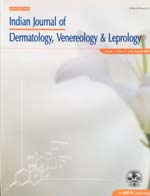
|
Indian Journal of Dermatology, Venereology and Leprology
Medknow Publications on behalf of The Indian Association of Dermatologists, Venereologists and Leprologists (IADVL)
ISSN: 0378-6323
EISSN: 0378-6323
Vol. 75, No. 6, 2009, pp. 588-592
|
 Bioline Code: dv09201
Bioline Code: dv09201
Full paper language: English
Document type: Research Article
Document available free of charge
|
|
|
Indian Journal of Dermatology, Venereology and Leprology, Vol. 75, No. 6, 2009, pp. 588-592
| en |
Prescription auditing of griseofulvin in a tertiary care teaching hospital
Kirubha, M. Hepsi Bai
Abstract
Background: Griseofulvin has been the mainstay of treatment for dermatophytosis since many years. Since it is a penicillium antibiotic and used commonly in the outpatient department, the prescription should be audited for its safety and quality. Clinical pharmacists being an important member of the healthcare system have an immense responsibility in delivering pharmaceutical care by auditing prescriptions in order to achieve rational and cost-effective medical care thereby improving patient′s Quality of Life (QOL).
Aims: To study the utilization of griseofulvin by auditing prescriptions, to assess the impact of griseofulvin on the QOL of patients and to emphasize role and responsibilities of a clinical pharmacist in the treatment outcome of dermatophytosis.
Methods: 120 patients prescribed with griseofulvin in the dermatology outpatient department were included in the study. On the basis of therapeutic response, improvement was graded at the end of the treatment regimen. Adverse drug reactions (ADRs) during the treatment period were recorded. Laboratory investigations were performed at baseline and at the end of treatment. Quality of Life was measured at baseline and at the end of therapy.
Results: 56.7% were females and 43.3% were males. The most common diagnosis was tinea corporis (44.17%) followed by tinea cruris (14.17%) and onychomycosis (9.17%). The most common ADR due to griseofulvin was headache (5.83%). 64.20% patients had complete cure following treatment with griseofulvin. The overall QOL score improved significantly following treatment with griseofulvin (P < 0.0001).
Conclusion: Griseofulvin can be used extensively for the treatment of dermatophytosis as it has no serious adverse effects and has higher cure rates. Treatment with griseofulvin significantly improves the QOL in patients with dermatophytosis.
Keywords
Dermatophytosis, Griseofulvin, Quality of life
|
| |
© Copyright 2009 Indian Journal of Dermatology, Venereology and Leprology.
Alternative site location: http://www.ijdvl.com
|
|
